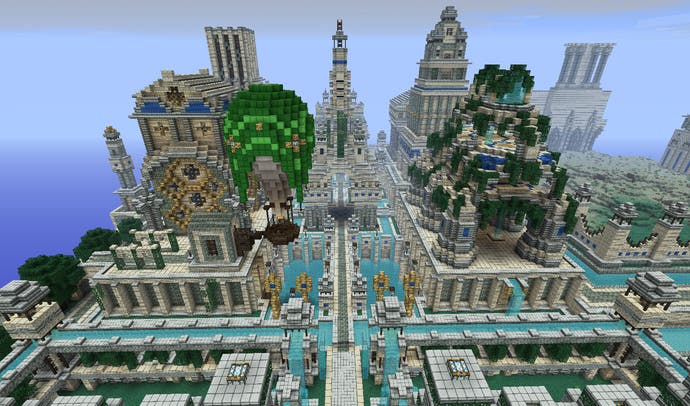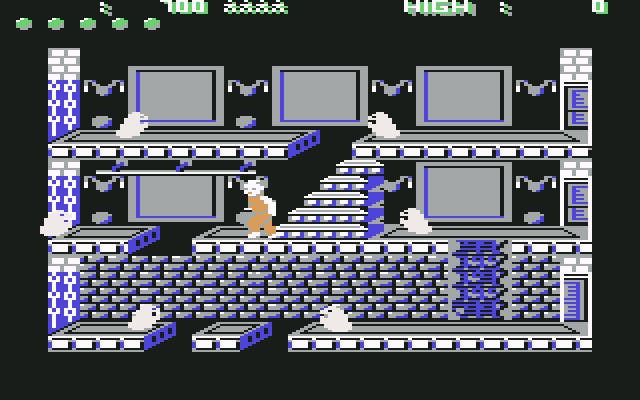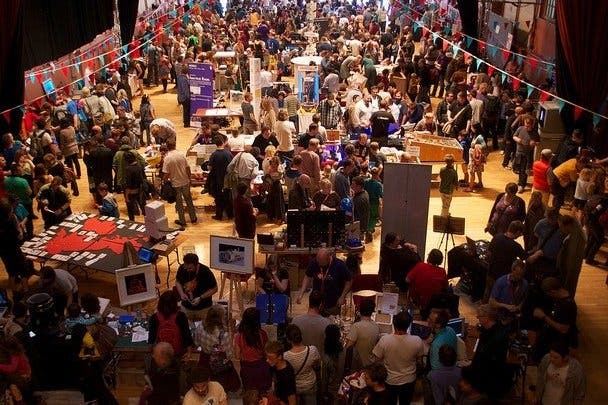How video games are helping to build a new generation
Things to make and glue.
Last Saturday, in central Brighton, I met a robot who showed me the future.
My daughter was with me, so he showed her the future, too. It was a future of pluck and ingenuity and optimism. You could get open-source cola there (alongside a tea towel printed with instructions so that you could make your own open-source cola at home), and the whole place smelled of glue guns. Even though the robot needed two friends to help move his cardboard pincer arms about, he was thoroughly convincing when he explained that he knew where the world was heading. And the destination, much like the sun reflecting off his tinfoil and chicken wire body, seemed very bright indeed: a paradise of recycled cardboard, repurposed technology and gleeful open-source cola self-sufficiency.
Most hearteningly, I suspect that in some small way this is the future that video games - and video game culture - are helping to build.
The robot was in town last weekend because he was drawing crowds for the Mini Maker Faire, which took over Brighton's Corn Exchange for a day of crafting, handiwork and toolboxy playfulness. The maker movement - which until recently I'm ashamed to admit I thought was a kind of mid-western rival to the Amish - is actually a technologically-inclined deployment of the DIY ethos that increasingly encompasses the aspects of existence that lie beyond a new lock for the garage door, a fresh tile for the leaky roof. It's often about finding the value in garbage, and it's always about fiddling around with your life until it works a little more interestingly. Makers can seem uncomfortably utopian at times, and there's the hint of a TED Talk megamix to their proposition - of the blithe acceptance that all of the world's problems can be solved by lasers and working in an office where you're allowed to skateboard indoors.
And yet! Taken at its simplest level, it's hard not to agree with the central constructivist tenets of the movement. You know: learn to do stuff for yourself, approach the world as if it is filled with possibilities, and when things go wrong, pop the lid and find a screwdriver. Ownership comes through knowing how something works. Ownership comes through understanding. This is not new thinking, but it still feels like very sympathetic thinking given the world we currently live in.

As the name suggests, the Mini Maker Faire is aimed at children, which is why I was particularly excited to take my daughter along. Having just turned one, she isn't ready to handle a soldering iron yet - she's still too busy with her steam shovel - but I wanted to see what's coming down the pipe for her and the rest of her generation. She seemed to enjoy the sights and the sounds, and the crush of people everywhere meant that she was spoilt for choice when it came to her favourite trick, which is touching a stranger on the arm and then staring at them very seriously for an awfully long time. In truth, though, I was the real recipient of maker wisdom that day.
That was the point, actually. I had realised how out of touch I was becoming a few weeks back when I heard that my daughter's older cousins are all obsessed with loom bands, which are these sort of bracelet things kids make these days from colourful little loops of rubber. At first, I thought loom bands were almost comically naff, but then I stopped to think about the ways that this generation's priorities are patently different from those of my own generation, and realised that maybe these loom bands weren't such a terrible development. I pondered how I would go about trying to explain Knight Rider or the A-Team or the hairsprayed appeal of Barry Van Dyke to an eight-year-old in 2014. Inevitably, I realised I was the comically naff one.
There were loom bands at the Maker Faire, but they were the most commercial of the wonders on offer. Hear that? Rubber band jewelry was the nod to the mainstream here. Beyond all this lay a couple of large and extremely crowded rooms filled with exhibits and workshops and books and electronics and things that I couldn't easily classify. There were standard handicraft elements like trestle tables where you could sit down and make mosaics, and there was more advanced stuff: robots that drew, robots that swam, computers that printed blankets with the periodic table on them, and a stand that encouraged you to construct Victorian crank-handled automata from pipe-cleaners and old coffee cups. Somebody had made a shark. Its jaws moved and everything.

And, crucially, games were everywhere. They were there in a side room packed with C64s and Amigas and Spectrums, where the kids could sit down and play things like Pong! and Ghost Chaser. They were there in the entry lobby, where families could race through a few rounds of Pac-Man, its maze exploded and projected onto a sphere. They were there in the craft stalls, where you could buy Mario scenes made from little beads that worked as pixels, or where you could pick up a Purple Tentacle knitted from thick wool, and they were there in dozens of glossy paperbacks promising to introduce you to the joys of Unity, or GameMaker.
More importantly, games were there in spirit: they just fit so well into the maker ethos that kids are increasingly growing up with that I wonder which part came first. Since games and makers found one another, I suspect it's been something of a symbiosis. DIY has benefited from the systemic playfulness of games, while games, in turn, have learned to take extremely rewarding risks by foregrounding the freeform, open-ended creativity of just making stuff, of just tinkering.
And tinkering, above all else, may be the strongest feature of the brain that games build. Games are frequently violent, and they're frequently about winning and about defeating somebody, but even the simplest shooter will feature an element that will only work properly if you really try and understand how it behaves in different situations, and even the most basic puzzler will offer scope for improvement through experimentation and rule-testing. Back in the days when I would play games like Ghost Chaser and wonder if graphics would ever get any better, us school kids already understood innately that the game that ran on the tape could be tinkered with in certain ways. We knew it had a secret face, and its secret face was code that might be altered. I remember stopping tapes at certain points during the loading process in order to enter cheat text that may or may not have turned out to be apocryphal, and I remember reverse-engineering the save code system of Nintendo World Cup so that I could play as Cameroon in the final. All it required was a pad and pencil and brutal exploitation of the Super Kick system. Voila: Cameroon were ready for silverware.

What I'm getting at is this: to be around games is to understand that games are technology, and that technology can be tweaked and broken and improved in interesting ways. Technology can be made to do pretty much whatever you want it to do, so long as you're willing to pay the price in effort. To be around games like Minecraft, like Incredipede, like Quadrilateral Cowboy is to understand that the power of WRITE is every bit as fearsome as the power of READ. That's not a catchy slogan, perhaps, but it feels like the kind of thinking that has allowed the Brighton Mini Maker Faire to become so popular by 2014 that the Corn Exchange is no longer big enough to house it properly - and the Corn Exchange is massive.
It's hard not to see this creative thinking as part of a wider trend, too, particularly in a week where Mojang's apparently up for sale for the sum of $2 billion. And beyond that, here are two other pieces of timely news. Lego has overtaken Mattel as the most successful toy-maker in the world: the brick has bested Barbie and Hot Wheels, and doesn't that feel entirely just? Elsewhere, Alibaba, a website I had never heard of until last week, is set to have what may well be one of the biggest IPO in Wall Street history. (Although, granted, it may also be a very dangerous bubble so maybe hang onto your money for a bit.)
Alibaba! I bet makers know about this one. Alibaba's like Amazon, except it's like Amazon for the kind of people whose idea of fun is making their own jewelry from rubber bands rather than stocking up on box sets of Air Wolf. Alibaba's all about what happens before the product comes together: it's Amazon designed for the generation that wants to make the stuff that Amazon will one day sell.
As far as I understand it, Alibaba matches you with Chinese manufacturers and wholesalers who are just itching to make that weird piece of very precisely tooled metal you need for your world-changing invention. Chinese manufacturers and wholesalers who make anything and everything, and will ship it in bulk. It's nothing less than a way of setting yourself up with a supply chain so you can bring a nutty idea to life in your garage and eventually take it to the masses - or to a Maker Faire.
I'm 36 years old and I can't make anything. I don't want my daughter to share my embarrassing fate. And, after last Saturday, I'm not sure she will have to. I already appreciate that Minecraft will be her Mario, and that her save files won't just track the bosses she's killed and the loot she's collected, but the houses she's built, the items she's crafted, and the worlds she's shared. These kids - these loom banded freaks - are going to try and change the way things work around here. And it's games, in part, that will have empowered them to do that.

